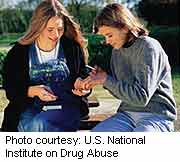
MONDAY, July 19 (HealthDay News) — Point-of-sale tobacco advertising is a major cause of teen smoking in the United States and should be banned, Stanford University Medical School researchers say.
These types of tobacco ads in places such as convenience stores, gas stations and small groceries are highly effective in terms of their impact on teens and greatly increase the chances that they’ll start smoking, according to Lisa Henriksen, a senior research scientist at the Stanford Prevention Research Center, and colleagues.
Their survey of 2,110 teens between 11 and 14 years old found that those who regularly visited stores with point-of-sale tobacco ads were at least twice as likely to try smoking as those who made infrequent visits.
“The tobacco industry argues the purpose of advertising is to encourage smokers to switch brands, but this shows that advertising encourages teenagers to pick up a deadly habit,” Henriksen said in a Stanford news release.
Point-of-sale advertising in retail outlets accounted for 90 percent of the tobacco industry’s $12.5 billion marketing budget in 2006, according to the researchers.
Henrikson herself was “surprised by the sheer number of cigarette brand impressions” — that is, cigarette ads, tobacco product displays and cigarette brand-labeled objects such as clocks, trash cans and cash register mats — in convenience stores near schools.
“The exposure is unavoidable. It’s impossible to miss,” she said.
The study appears in the August issue of the journal Pediatrics.
Henriksen noted that the decline in teenage smoking has leveled off in recent years. According to federal statistics, high school students who reported current cigarette use declined sharply from a peak of 36.4 percent in 1997, to 21.9 percent in 2003. Then, the percentage dropped just a bit to 19.5 in 2009.
“The huge decreases are really starting to slow,” she said. “The train won’t continue downhill without further action. Regulating retail marketing would be ideal for smoking prevention.”
More information
The U.S. Centers for Disease Control and Prevention has more about kids and tobacco.

